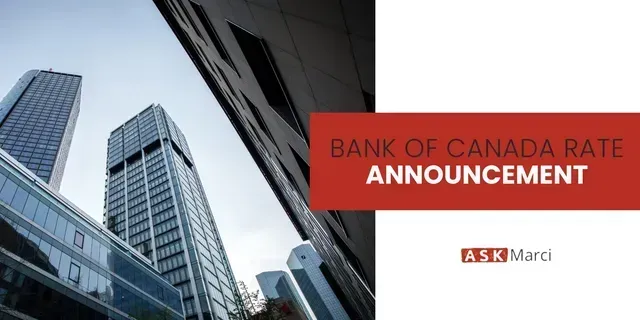3 Reasons Canadian Mortgage Rates Will Never Hit 5%
Canadian regulators may soon force borrowers to qualify at interest rates two percentage points above the contract rate.
With many posted mortgage rates now approaching and even surpassing 3.00% (depending on the term), this means borrowers will soon need to show they can afford payments based on rates of 5.00%+.
The justification is that regulators want Canadians to be prepared when interest rates rise, but that’s a hollow excuse. It’s a punitive macroprudential rule that is disconnected from reality.
Interest rates can only rise if inflation accelerates, but every force in the world is pushing in the other direction. We’re in an age of no inflation and it will completely change borrowing, lending and how the mortgage market works.
Here are three reasons you will never have to pay 5.00% on a typical 5-year fixed mortgage, but why you could be paying more in other ways:
1) There Is No Inflation
There is only one kind of inflation that matters to the Bank of Canada: wage inflation. Prices might rise on everything for a year or two, but if wages don’t go higher with them, the cycle hits a wall because people won’t have the money to pay those higher prices. Demand falters and prices flatten.
The classic wage-price spiral of the ‘70s and ‘80s will never return and here’s why:
The simple Economics 101 model is supply and demand. As the economy grows and companies expand, the supply of idle workers eventually runs out. That means more bargaining power for workers and wages rise. It’s something the Bank of Canada calls the “output gap” or “slack”.
This paradigm is now forever broken. The first reason why is that globalization means the supply of workers is no longer limited to where you are. Factories and many service industries can move to where workers are cheapest, and until there are jobs for the billions of workers on the planet there will always be slack.
Even if all those workers could find jobs it still wouldn’t matter because automation is a far bigger driver of disinflation. Workers everywhere are being replaced by technology. It’s not just robots, but also computers, algorithms and improved processes adopted from abroad. We are still in the very early stages of this change and it’s accelerating daily.
Add in de-unionization, Amazon-style competition, precarious labour, other technology and the lingering collective psychological shock of the financial crisis and it’s a Quantitative Easing-miracle that prices haven’t fallen already.
This isn’t just a Canadian phenomenon. It’s not even a developed market phenomenon; inflation is low virtually everywhere. Even emerging markets that are growing far faster than Canada’s economy aren’t generating runaway inflation.
China’s economy continues to grow at a nearly 7% annually, but inflation is just 1.8% and has been below 3% for four years. Average mortgage rates for homebuyers there remain under 5.00%, and until rules were tightened this year, borrowers were typically paying less than 4.00%.
2) The Pain Would be Catastrophic
The second reason that rates will never rise to beyond 5.00% in Canada is that there are now far too many people who wouldn’t be able to make their payments. The government’s last round of new mortgage rules was a noble effort to reign in the housing market, but the horse has already left the million-dollar barn. Many borrowers would be forced to sell their homes, and those who could afford to stay would have their spending power cut dramatically.
A two-percentage-point rate increase on a $500,000-mortgage boosts the payment by at least $500 per month. A 5.00% rate on a million-dollar mortgage means $50,000 spent per year in interest alone. That’s a devastating bite out of a household’s disposable income, which is crucial for sustaining the economy.
Canada is often described as a resource economy, but it’s far more dependent on the health of the consumer than the price of oil. If consumers begin to suffer, it will quickly show up in the economic data and the Bank of Canada would be forced to do a quick U-turn on rates.
Even if Canadians could afford those higher rates, it would be a disaster politically for any governing party. Making people feel poorer is a sure-fire way to find yourself voted out of Parliament.
3) Rules Are the New Rates
While there is no inflation in the classic sense, prices are rising. You don’t need to look any further than soaring real estate or sizzling global stock markets.
The crux is that there are two types of inflation. There’s the classic consumer inflation, which is tied to industrial, commercial and labour prices that are doomed to stay low forever.
Then there is asset-price inflation. Low rates have changed the economics of borrowing and investing. If you can borrow at 3.00%, virtually anything that returns more than that is a viable investment. So asset prices rise until even meagre returns are no longer economical. Add in scarcity, tighter land-use rules, foreign capital and the growing desire to live in urban centres and it’s a perfect storm for housing.
Ultimately, this is a big political problem. People want to live in cities and it’s unpopular for voters to be spending all their money on mortgage payments. It’s also bad for business to have workers commuting unreasonable distances.
There are two real solutions and two that governments will try first.
The ultimate solution to high house prices is to make it easier and cheaper to build more housing. That’s politically unpopular now but could change someday. For now, governments continue to make it tougher to build the homes people want at prices they can afford.
The other way to cool house prices is to raise interest rates, however that’s far too blunt of a tool. Forcing businesses or rural homeowners to borrow at higher rates would be an unnecessary blow. The Bank of Canada has already gone too far.
The two solutions governments are trying first are the two things they always do in a market crisis: blame foreigners and blame the speculators.
So far the execution has been sloppy, but politicians have sent a powerful signal that they are now part of the equation. So don’t worry about interest rates, worry about what’s coming from regulators.
This article was written by Adam Button , Chief Currency Analyst and Managing Editor of ForexLive.com , one of the most-visited sites for foreign exchange news and analysis. It was originally posted here.
Share












